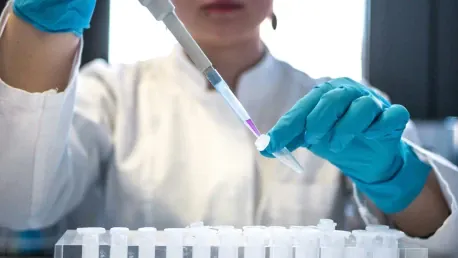The University of Maine’s Hess Lab is at the forefront of groundbreaking research aimed at developing a universal treatment for the flu virus. Under the guidance of physics professor Sam Hess, students are employing advanced physics and molecular biology techniques to understand the mutation and infection mechanisms of influenza viruses. This research, supported by a significant grant from the National Institutes of Health (NIH), holds promise for creating more effective treatments against various viruses.
Understanding Influenza Virus Mutation and Infection
Advanced Techniques in Viral Research
The research team utilizes cutting-edge methods such as single molecule microscopy, super-resolution microscopy, and fluorescence spectroscopy. These techniques allow them to capture detailed images of molecular interactions during viral infection. By visualizing these interactions at the nanoscale, the team can gain crucial insights into the ways influenza viruses mutate and hijack host cells. The ability to see these interactions at such a detailed level is invaluable, as it provides unprecedented information about the initial steps of viral infection.
Single molecule microscopy offers the advantage of looking at individual viral particles and their interactions with host cells, while super-resolution microscopy pushes the limits of traditional light microscopy, allowing researchers to see beyond the diffraction limit of light. Fluorescence spectroscopy, on the other hand, provides data about the molecular environment and the dynamic processes taking place during infection. Together, these techniques create a comprehensive picture of how the influenza virus operates, shedding light on potential weaknesses that can be targeted by antiviral treatments.
Hemagglutinin (HA) and Host Cell Interaction
A key focus of the research is the interaction between the flu virus’s hemagglutinin (HA) spike protein and the host cell’s plasma membrane. HA’s attachment to the cell membrane is a critical step in the infection process, enabling the virus to inject its RNA into the cell. Once inside, this viral RNA hijacks the cell’s machinery, leading to the production of new viral particles and perpetuating the infection cycle. Understanding this interaction is crucial as it provides a point where intervention could stop the virus in its tracks.
HA is a spike-shaped protein that protrudes from the surface of the influenza virus, making it the first point of contact with the host cell. The viral particles bind to sialic acid receptors on the surface of the host cell, initiating the infection process. By targeting HA and its interaction with the host cell, researchers hope to develop treatments that can block this initial binding, preventing the virus from gaining entry into the cell. This strategy could be particularly effective as it addresses a fundamental and conserved aspect of the virus’s infection mechanism.
Investigating Conserved HA Tail and PIPs
Role of Phosphatidylinositol Phosphates (PIPs)
The students are particularly interested in the conserved tail of HA and its interaction with specific host cell membrane lipids known as phosphatidylinositol phosphates (PIPs). These lipids, including PI4P and PIP2, play crucial roles in cell trafficking and signaling. The interaction between the conserved HA tail and these phosphates is essential for the assembly and release of new viral particles from infected cells. By understanding and disrupting this interaction, researchers aim to hamper the virus’s ability to replicate and spread.
Phosphatidylinositol phosphates are minor components of cell membranes but play significant roles in regulating various cellular processes. They are involved in signaling pathways that control cell growth, survival, and metabolism. By specifically focusing on PI4P and PIP2, the team at the Hess Lab is identifying potential bottlenecks in the viral life cycle that can be exploited to develop novel antiviral strategies. If successful, these strategies could lead to treatments that remain effective even as the virus undergoes frequent mutations.
Potential for Universal Flu Treatments
By focusing on conserved features of the virus, such as the HA tail, the research aims to develop treatments that remain effective even as the virus mutates. Influenza viruses are notorious for their high mutation rates, which often render vaccines and treatments less effective over time. However, by targeting these conserved elements, researchers hope to create a universal treatment that provides robust defense against a variety of influenza strains, potentially revolutionizing how flu is treated in the future.
Moreover, the research at the Hess Lab highlights the importance of understanding the underlying mechanisms of viral infections at a molecular level. By gaining a deeper knowledge of how viruses interact with host cells, scientists can design more precise and effective therapies. This approach not only promises to improve flu treatments but also sets the stage for tackling other viral infections more effectively. The insights gained from studying influenza could be applied to other viruses, paving the way for the development of broad-spectrum antivirals.
Educational and Career Impact
Hands-On Research Experience
The research project offers valuable hands-on experience for both undergraduate and graduate students. They gain practical skills in biophysics and molecular biology that enhance their career prospects significantly. For instance, Tiance Yang is using his work on molecular dynamics as part of his senior capstone project, a critical component of his undergraduate education that allows him to apply classroom knowledge to real-world problems. Likewise, graduate student David Winski is preparing for a career in biophysical research by participating in these groundbreaking studies, gaining expertise that will be instrumental in his future endeavors.
Students involved in this research are not only learning advanced techniques but also developing critical thinking and problem-solving skills. They are exposed to the entire research process, from hypothesis generation to experimentation and data analysis. This comprehensive experience prepares them for future roles in scientific research and innovation, making them valuable assets in any research setting. The opportunity to contribute to a project with significant public health implications also instills a sense of purpose and motivation in these aspiring scientists.
Preparing Future Scientists
The educational benefits of this research extend beyond technical skills. Students learn to think critically, solve complex problems, and collaborate effectively. These experiences prepare them for future roles in scientific research and innovation, contributing to the broader scientific community. Engaging in interdisciplinary research allows students to appreciate the interconnectedness of different scientific fields, fostering a holistic understanding of how complex biological systems operate. These well-rounded experiences ensure that graduates are not only technically proficient but also equipped to contribute to a rapidly evolving scientific landscape.
Moreover, the project emphasizes the importance of mentorship and collaboration. Working closely with experienced researchers like Professor Sam Hess offers students invaluable guidance and feedback, helping them navigate the challenges of scientific research. This mentorship cultivates a supportive and stimulating learning environment where students can thrive and reach their full potential. The skills and knowledge gained from such experiences are transferable and highly valued, setting the stage for successful careers in academia, industry, or government research.
Broader Applications and Universal Vaccine Potential
Beyond Influenza
One of the overarching goals of the research is to apply the findings beyond influenza. By understanding the fundamental mechanisms of viral infection, the team hopes to develop treatments that can be effective against a range of viruses. This could pave the way for a universal vaccine or antiviral therapy, addressing some of the most pressing challenges in infectious disease control. The potential to extend these findings to other viruses underscores the significance of the research, highlighting its broad applicability and transformative potential.
The insights gained from studying the influenza virus can inform the development of treatments for other pathogens that share similar infection strategies. By targeting conserved viral features and critical host-virus interactions, researchers can design therapies that are less susceptible to resistance. This approach aims to create a versatile arsenal of antivirals capable of combating diverse viral threats. Achieving this goal would be a significant milestone in public health, offering more robust and long-lasting protection against a multitude of viral infections.
Combining Experimental Data with Simulations
The research combines experimental data with molecular simulations to create detailed models of viral behavior. These models provide insights into how viruses interact with host cells and how these interactions can be disrupted. This multidisciplinary approach enhances the potential for developing innovative treatments by integrating theoretical and empirical data. Molecular simulations offer a powerful tool for visualizing and predicting the behavior of complex biological systems, complementing experimental observations and enabling researchers to test hypotheses in silico before validating them in the lab.
By leveraging both experimental and computational methods, the team can explore a wide range of scenarios and identify potential targets for intervention. This comprehensive approach ensures that the treatments developed are based on a thorough understanding of the virus’s behavior at multiple levels. The integration of molecular simulations also accelerates the research process, allowing for more efficient identification and optimization of potential therapeutic targets. Ultimately, this combination of techniques fosters a deeper and more nuanced understanding of viral infections, paving the way for more effective and tailored antiviral therapies.
National Institutes of Health (NIH) Grant
Financial Support for Research
The research is supported by a $430,000 grant from the National Institutes of Health. This funding enables the team to explore the role of different phosphates found in the cell membrane and their involvement in the infection process. Such financial support underscores the importance of this research and its potential impact on public health. It allows the researchers to access state-of-the-art equipment and resources, conduct comprehensive studies, and collaborate with other experts in the field. The NIH grant represents a vote of confidence in the project’s potential to yield significant advancements in antiviral therapy.
The grant also facilitates the training and development of future scientists. By providing funding for research assistants, lab supplies, and other essential resources, the NIH grant ensures that students and researchers can focus on their work without financial constraints. It fosters a productive research environment where innovative ideas can flourish, contributing to the overall progress of the scientific community. Additionally, the grant’s emphasis on studying phosphates in the cell membrane highlights a strategic approach to identifying vulnerable points in the viral infection process that can be targeted for therapeutic intervention.
Targeting Phosphates for Treatment Development
By studying the role of PI4P and PIP2 in viral infection, the team aims to identify new targets for antiviral treatments. These phosphates are integral to the virus’s ability to infect cells and assemble new viral particles. Targeting these interactions could lead to the development of more effective antiviral therapies. Disrupting the virus’s reliance on these critical membrane components may impair its ability to propagate, providing a novel approach to controlling viral infections. This strategy has the potential to yield treatments that are effective against a wide range of viral pathogens.
The targeted approach to antiviral treatment development is particularly promising because it addresses fundamental aspects of viral replication that are less likely to change over time. By focusing on conserved elements of the viral life cycle, researchers aim to create therapies that maintain their efficacy despite the virus’s high mutation rates. The study of PI4P and PIP2 serves as a crucial step in this process, offering insights into how these phosphates facilitate viral replication and providing a basis for designing targeted interventions. The ultimate goal is to translate these findings into practical treatments that can improve public health outcomes.
Conclusion
The University of Maine’s Hess Lab is leading pioneering research to develop a universal treatment for the flu virus. Under the direction of physics professor Sam Hess, students are using sophisticated physics and molecular biology techniques to delve into the mutation and infection processes of influenza viruses. This critical research is backed by a substantial grant from the National Institutes of Health (NIH) and holds significant promise for advancing more effective treatments against a range of viruses.
The research team is employing state-of-the-art technology to study how influenza viruses change and spread, hoping to uncover patterns that can be targeted to prevent and treat infections more effectively. By understanding the underlying mechanics of how these viruses mutate and infect humans, the lab aims to formulate a treatment that could be universally applied to different strains of the flu. This endeavor could not only enhance flu treatment but also provide insights that might be applicable to other viral infections, potentially revolutionizing the way we approach viral diseases and public health challenges.









